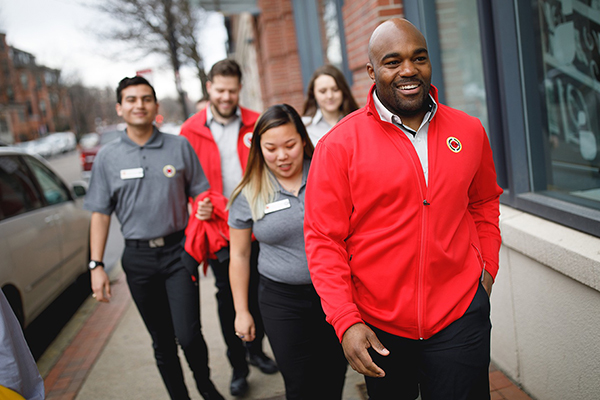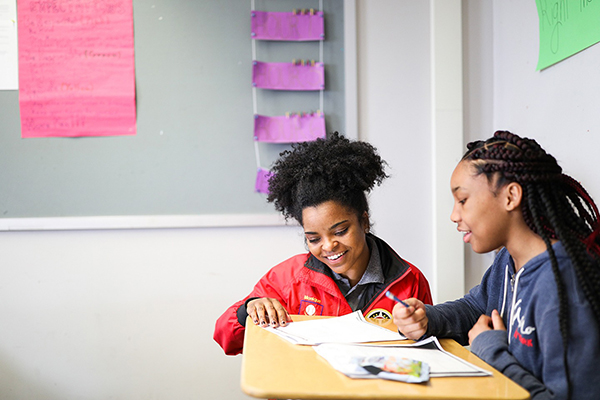Our impact
Students stay in school, are more engaged and perform better academically when they feel connected to at least one adult at school. That is our role, to ensure that students have the relationships and resources to help them thrive in and out of school. Donate now to support our mission.
Schools partnering with City Year are up to 3x more likely to improve proficiency rates in math.
Schools partnering with City Year are 2x more likely to improve on state English assessments.
School staff agree that City Year AmeriCorps members help to foster a positive learning environment for their students.
Our alums are working in a wide range of professions, including education, business, law and public policy.
Supporting students during a pandemic and beyond
What the COVID-19 Pandemic Taught Us
This pandemic may be unprecedented in its nature and scale, but the problems it has exposed are not. The gift of a crisis is that it reveals what really matters. It turns out, we’ve been doing what really matters—City Year’s focus on integrated academic and social-emotional skill development is now widely understood to be a critical component of students’ successful recovery from interrupted schooling and disruption caused by the pandemic. More than “nice to have”, these integrated services are essential to students’ recovery from the challenges laid bare by this pandemic. City Year has been and will continue to be a key partner in building relationships with students and helping them develop as sense of belonging and connection to the school community, which will be critical to support their engagement and attendance next year.
Our AmeriCorps members serve as student success coaches and are prepared to serve alongside our partners to ensure students:
- Reconnect with their school community
- Re-engage in their learning
- Recover from lost instructional time
Learn more about the student success coach role at City Year:
Donate to support City Year's mission
This past year City Year and our dedicated AmeriCorps members helped thousands of students navigate an unprecedented school year. This is a huge milestone, but there is so much to be done.
DonateMeasuring impact
City Year provides a powerful double bottom line: improved outcomes for students in systemically under-resourced schools and the cultivation of the next generation of leaders through our alum.
Measuring success
Research shows that providing students with positive, caring, consistent adult relationships at school helps to keep students on track to graduate with the skills and mindsets essential for success in college, career and life.
Read about individual success stories
Our team at Ascot Elementary School had the pleasure of hosting the U.S. Deputy Secretary of Education Cindy Marten to...
Read more about U.S. DSEd Cindy Marten Visits Ascot ES to Spotlight Impact of Student Success CoachesOver the last few months, City Year Memphis and their local Starbucks partners—along with several other community organizations, businesses and...
Read more about Creating hope and opportunity in Memphis through partnershipsIn 2022, City Year, in partnership with Rick Cavender and Harvey Najim, introduced our annual Bridge Builder Award which is...
Read more about City Year San Antonio | Bridge Builder AwardeesAs we celebrate a decade of service to the Jacksonville community, it’s impossible to overlook the significant contributions of Veronika...
Read more about Reflecting on 10 years with City Year Jacksonville's Veronika McDougaldCity Year has a strong return on investment
Every dollar invested in City Year is matched 1:1.
For schools we partner with, City Year is 78% more cost effective than contracting with individual providers to deliver our services.
Students in schools with City Year gained one month of additional learning, compared to similar schools without City Year.
A smart investment
In a 2018 white paper, Deloitte Consulting LLP examined the value and growth potential of City Year’s services, including City Year's return on investment.
Download the paperBuilding civic leaders
47% of City Year alumni work in education, including 16% who are classroom teachers.
94% of City Year alumni agree that their City Year experience had a significantly positive impact on their lives.
City Year alumni are 45% more likely to be civically engaged or belong to a community organization.
Alumni impact
City Year's 34,000 alumni are increasingly taking on leadership roles and making significant contributions as leaders who can mobilize diverse groups to tackle complex challenges across a range of professional fields.
Download the report

















